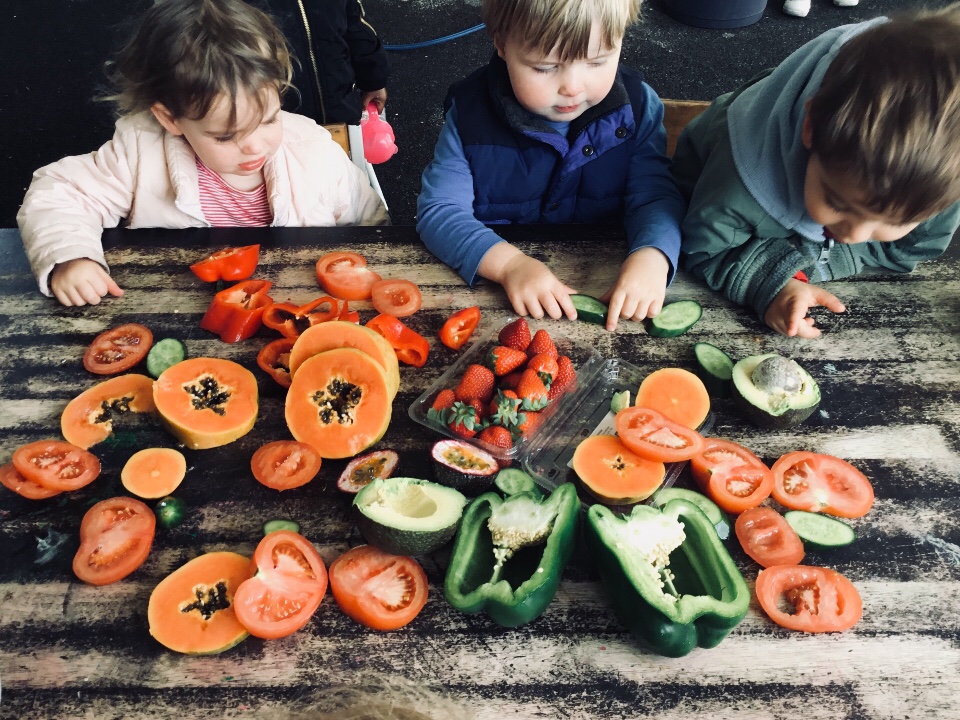Is it a fruit or a vegetable?
- Sophia Vidovic White
- Feb 24, 2019
- 3 min read
Thursday 6th September 2018
Spring has arrived. Plants are sprouting, flowers are blooming and vegetables are growing. It's the ideal opportunity for children to learn about nature and growing foods.
Our team set about planning another taste testing experience today, collecting fruits and vegetables that children may not have tasted before, such as tropical fruits and seasonal vegetables and mixed this in with foods that they were familiar with. We tried to ensure that a spread of different foods was represented, and we considered using varieties of plants that have sensory and textural qualities as well. Sensory plants are plants that have a special smell, taste, touch and sight qualities. We presented the children with a mix of fruits and vegetables with capsicum, tomatoes, papaya, passion fruit, strawberries and cucumbers and much more.
Pre-Kinder children will all have different expectations and learning experiences from exposure to varieties of fruit and vegetables. Our aim was for children to understand that some fruits and vegetables come from seeds and to identity where these seeds are. We looked at the parts of a fruit and vegetable and to select a food that they have not tasted before, or would like to taste again.
This activity provides children with opportunities to:
+ Become familiar with a variety of fruits and vegetables.
+ Be made aware of the importance of eating fruits and vegetables each day.
+ To use their senses to discover food
+ Explore the range of foods that are available
+ Describe how foods are different
+ Sample new foods and identify reasons for choosing food.
+ Begin to group foods into fruit and vegetables
+ To see that seeds come in various forms (seeds growing on the exterior of strawberries and stones in berries such as avocados)
We began by displaying an assortment of fruits and vegetables, and asked the children to identify them. The children were encouraged to state their observations as they compare the fruits and vegetables as we explained that some of the foods are fruits and some are vegetables, and that all of them grow from plants. The difference between fruits and vegetables is that fruits are the ripened part of a flowering plant that contains the seeds. Vegetables grow from plants, but they do not have seeds on or inside them.
We asked the children to begin describing the food through touch, adding words to extend their vocabulary (smooth, bumpy, sweet smoky, rough, cold, strong, round, sharp, nice, hard or spiky). We then prompted the children to then describe how the food smelt (sweet, strong, good, bad).
We asked a few more questions to open up discussion…
Where do you get fruits and vegetables from? The children gave us a variety of answers with grocery stores, fruit and vegetable stands, farmers’ markets, and gardens. “The market, a lady gave it to you. Two dollar for one.” Said Sophie. “The shop with food” Answered Frankie.
Name 2 fruits you must peel before you eat? “Peel a banana” responded Finnley. “Peel the skin off…avocado.” Said Michael as he tucked into a whole avocado.
What fruits would you usually put in a fruit smoothie? “Banana and pineapple…orange juice is what I drink.” Ava responded.
Do strawberries have seeds? “No” said everyone. We discovered that the seeds are on the outside of a strawberry.
What part of the vegetable or fruit can’t you eat? Michael pointed to the avocado and said “Big seed. Rock here you don't eat it.”
Why do fruits have seeds? “So it can grow another one.” Said Ava.
From there we began sorting the foods and placing the fruits on one side of the table and vegetables on the other. The foods were cut in half and in slices to find out which ones contain seeds. One at a time, we cut each of the vegetables and fruit in half, and looked for the seeds. We enlisted the children’s help with sorting the foods – fruits on one side of the table, vegetables on the other.
In order to avoid any confusion with some vegetables that are actually fruits, such as cucumbers, tomatoes, and peppers, we added a middle section to the sorting. We explained to the children that some fruits are used as vegetables when we cook, but they are actually fruits. Tomatoes were a clear example.
To expand on our new learning, we will collect the seeds we find, place these on small paper plates, and label them. Contained in a zip-closed bag, we could place the bags in the discovery area where our children can use magnifying glasses to inspect the seeds and discuss their observations. We could also make a vegetable or fruit salad with plastic knives and clean plates to use for cutting up the vegetables and fruits. As the foods are cut, we can have the children put vegetables in one bowl and fruits in a separate bowl to eat as part of their routine meal time.




























Comments